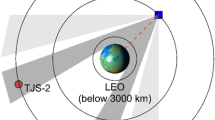Abstract
The combination of GPS measurements and high-fidelity dynamic models via a Kalman filter/smoother, known as the reduced dynamic technique, allows 3D positioning of Low Earth Orbiters to the sub-decimeter level. Such accuracies can only be achieved if the GPS data are nearly continuous, post-processed and a dual-frequency receiver is utilized. The focus of this study is to quantitatively analyze the degradations in position accuracy in the presence of various limitations or constraints, which can be brought on by mission hardware limitations, for example, on micro- or nanosatellites. The constraints explored in this study are as follows: the use of single-frequency data only; real-time processing; limited dynamic modeling due to computing capabilities; and non-continuous GPS receiver operation due to power limits. The experiments are conducted with 6-h data arcs for 7 separate days using data from the CHAllenging Mini-Satellite Payload. A 3D root mean square (rms) error of 15 cm is observed in the best-case solution, in which dual-frequency data are post-processed with all available data. Various levels of accuracy degradations are observed as constraints are placed on this best-case solution. The 3D rms error of the post-processed, single-frequency solution is 68 cm and 1.3 m for the real-time, dual-frequency solution. In very challenging environments, for example, with the receiver on for only 10 min of a 90-min orbit, the 3D rms increases to 350 m.









Similar content being viewed by others
References
Beutler G (2005) Methods of celestial mechanics: application to planetary system, geodynamics and satellite geodesy. Springer, Heidelberg
Bock H, Jaggi A, Dach R, Schaer S, Beutler G (2008) GPS single-frequency orbit determination for low earth orbiting satellites. Adv Space Res 43(5):783–791. doi:10.1016/j.asr.2008.12.003
Brown R, Hwang P (1997) Introduction to random signals and applied Kalman filtering, 3rd edn. Wiley, Canada
Erdogan E, Karslioglu MO (2009) Near real time orbit determination of BILSAT-1. Recent Adv Space Technol. RAST’09. In: 4th international conference, June 11–13. doi:10.1109/RAST.2009.5158271
Harris I, Priester W (1962) Time-dependent structure of the upper atmosphere. J Atmos Sci 19(4):286–301. doi:10.1175/1520-0469(1962)019<0286:TDSOTU>2.0.CO;2
Jaggi A, Hugentobler U, Bock H, Beutler G (2007) Precise orbit determination for GRACE using undifferenced or double differenced GPS data. Adv Space Res 39(10):1612–1619
Kahr E, Montenbruck O, O’Keefe K, Skone S, Urbanek J, Bradbury L, Fenton P (2011) GPS tracking on a nanosatellite—the CanX-2 flight experience. In: Presentation to 8th presented at international ESA conference on guidance, navigation & control systems, Karlovy Vary, Czech Republic, June 5–10
Kaula W (1966) Theory of satellite geodesy. Blaisdell Publishing Company, Waltham
Kouba J, Héroux P (2001) Precise point positioning using IGS orbit and clock products. GPS Solut 5(2):12–28
Lei J, Thayer JP, Wang W, McPherron RL (2011) Impact of CIR storms on thermosphere density variability during the solar minimum of 2008. Sol Phys. doi:10.1007/s11207-010-9563-y
Leick A (2004) GPS satellite surveying, 3rd edn. Wiley, Hoboken
Leung SYF, Montenbruck O, Bruninga B (2001) Hot start of GPS receivers for LEO microsatellites. 1st ESA workshop on satellite navigation user equipment technologies NAVITEC 2001, ESTEC Noordwijk, 10–12 December
Mander A (2011) Constrained GPS-based precise orbit determination of low earth orbiters. M.Sc. Thesis, Department of Earth and Space Science and Engineering, York University, Toronto, Canada
Mander A, Bisnath S (2010) York University, Constrained GPS precise orbit determination for low-earth-orbiters. In: Proceedings of ION GNSS, Institute of Navigation, Portland, OR, September, pp 2789–2796
Montenbruck O (2000) An epoch state filter for use with analytical orbit models of low earth satellites. Aerosp Sci Technol 4(4):277–287. doi:10.1016/S1270-9638(00)00133-4
Montenbruck O, Gill E (2005) Satellite orbits. Springer, Berlin
Montenbruck O, van Helleputte T, Kroes R, Gill E (2005) Reduced dynamic orbit determination using GPS code and carrier measurements. Aerosp Sci Technol 9(3):261–271. doi:10.1016/j.ast.2005.01.003
Svehla D, Rothacher M (2003) Kinematic and reduced-dynamic precise orbit determination of low earth orbiters. Adv Geosci 1:47–56
Yamaguchi S, Tanaka T (2006) GPS Standard Positioning using Kalman Filter. SICE-ICASE international joint conference, Bexco, Busan, Korea, October 18–21, pp 1351–1354. doi:10.1109/SICE.2006.315572
Yunck T, Wu S, Wu J, Thornton C (1990) Precise tracking of remote-sensing satellites with the global positioning system. IEEE Trans Geosci Remote Sens 28(1):208–216. doi:10.1109/36.45753
Acknowledgments
The Natural Sciences and Engineering Research Council of Canada has provided financial support for this research, and JPL, CDAAC, CDDIS and NRCan have provided data used in the experiments.
Author information
Authors and Affiliations
Corresponding author
Rights and permissions
About this article
Cite this article
Mander, A., Bisnath, S. GPS-based precise orbit determination of Low Earth Orbiters with limited resources. GPS Solut 17, 587–594 (2013). https://doi.org/10.1007/s10291-012-0303-7
Received:
Accepted:
Published:
Issue Date:
DOI: https://doi.org/10.1007/s10291-012-0303-7




